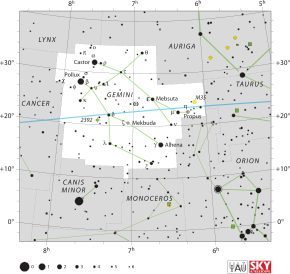Gemini (constellation)
- For information on the US space program named Gemini see Project Gemini.
- In mythology, the Gemini are Castor and Polydeuces.
| Constellation | |
 | |
| Abbreviation | Gem |
|---|---|
| Genitive | Geminorum |
| Right ascension | 7 |
| Declination | 20 |
| Area | 514 sq. deg. (30th) |
| Meteor showers | |
| Bordering constellations | |
| Visible at latitudes between +90° and −60°. Best visible at 21:00 (9 p.m.) during the month of February. | |
Gemini (♊, and Latin for twins) is one of the constellations of the zodiac. It is part of the winter sky, lying between Taurus to the west and the dim Cancer to the east, with Auriga and the near-invisible Lynx to the north and Monoceros and Canis Minor to the south. The Gemini program is named for it.
Notable features
Gemini includes two bright stars, named after the two twins, who correspond to the Dioscuri in Greek mythology - Castor (α), a pretty telescopic binary (actually sextuple), and Pollux (β), which is brighter and more southwesterly. The other stars are relatively dim - only one, Alhena (γ) is ever seen from a large city - and trace out a rectangle to the southeast.
The planet Pluto was discovered in this constellation in 1930, near the star Wasat (δ Geminorum).
Notable deep sky objects
The brightest deep sky object of Gemini is M35, an open cluster of 5th magnitude, 2 800 light-years from earth. It is northwest of η Geminorum, near the western edge of the constellation.
Mythology
Since this constellation is easily viewable as two parallel stick figures [1], considering faint stars visible to the naked eye, it was associated with the myth of Castor and Polydeuces (also known as the Dioscuri). The myth of these twins heavily concerns cattle theft, and may be connected to early views of the milky way, as a herd of dairy cows or cattle, by which they are situated.
The orientation of the constellation can vary (since they readily form stick figures whether leaning right or left), though the twins are usually viewed as left leaning. However, when right leaning, one of the twins resides in the milky way, and the other outside it, a situation making it appear that one of the twins is stealing the cattle, and the other is observing. In this situation, together with the area of the sky that is deserted (now considered as the new and extremely faint constellations Camelopardalis and Lynx), and the other features of the area in the Zodiac sign of Gemini (i.e. Orion, Auriga, and Canis Major), this may be the origin of the myth of the cattle of Geryon, which forms one of The Twelve Labours of Herakles.
Astrology
The astrological sign Gemini (May 21 - June 20) is associated with the constellation. In some cosmologies, Gemini is associated with the classical element Air, and thus called an Air Sign (with Libra and Aquarius). It is also one of the four mutable signs (along with Virgo, Sagittarius, and Pisces). Its polar opposite is Sagittarius. Its ruling planet is Mercury. Each astrological sign is assigned a part of the body, viewed as the seat of its power. Gemini rules the hands. The symbol for Gemini is the twins. Gemini qualities include a quick mind, silver-tongued eloquence, facility using the hands, and an ability to see many facets of a given issue.
Some famous Geminians: Dante Alighieri, Ralph Waldo Emerson, Walt Whitman, Paul Gauguin, W.B. Yeats, Thomas Mann, Stan Laurel, Cole Porter, Moe Howard, John F. Kennedy, Dean Martin, Judy Garland, George H.W. Bush, Marilyn Monroe, Allen Ginsberg, Bob Dylan, and Paul McCartney.
